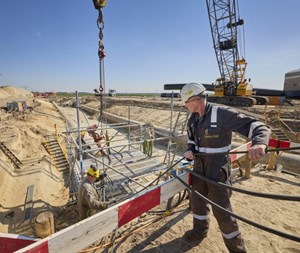News
Gasunie: Underway with H2 pipelines in the north of the Netherlands
H2 will play a pivotal role in the energy transition, particularly in the industrial sector where you find the major gas consumers that need to switch to sustainable energy in order to decarbonize. To connect industrial companies in the Netherlands with each other, with H2 storage facilities and import locations, and with locations abroad, we are building a H2 pipeline network. For this purpose we are converting as many decommissioned gas pipelines as possible to ready them for the transmission of H2. Jarno Geuzinge is the project manager responsible for the construction of the H2 network in the northern region of the Netherlands.
Connected nationwide. The northern industrial areas of Eemshaven and Delfzijl are home to major potential producers and consumers of H2.
Connection to the national network is therefore important, according to the Ministry of Economic Affairs and Climate (EZK), which commissioned Gasunie to build a network. This network should serve to further stimulate the supply and demand of H2, Jarno said, “By connecting to the national H2 network we ensure that industry has access to H2 as a cleaner form of energy. For example, while the Chemelot Industrial Park in Limburg consumes a lot of energy, hardly any H2 is being produced in the area. By linking this site to H2 production sites in Groningen, Zeeland and Amsterdam, carbon emissions can be reduced enormously. So, such an expansive network will likely result in an increasing demand for H2.”
HyStock, the Dutch H2 storage facility in Zuidwending, will also be connected to the network, and there will be two cross-border connections with Germany as well. Jarno said, “That’s also important for the importers, and for the H2 producers in our cluster, given that they also have consumers in Germany. In short, we are seeing to it that producers and consumers will eventually have 24/7 access to a well-functioning H2 network.”
Benefits of preparing now. To build all these connections, in the northern parts of the Netherlands alone Gasunie subsidiary Hynetwork will be converting around 130 kilometers of natural gas pipeline and laying another 80 kilometers of new pipeline. Construction will really pick up steam in 2026 and is expected to continue until the end of 2027. “We are already busy making preparations,” said Jarno. “We will be connecting two existing gas pipelines to create one long transmission pipeline, running over 105 kilometers from Tjuchem to the Ommen compressor station. We have moved this part of the work forward because that offers major advantages: this way we only have to inspect one long pipeline instead of two, a move that will save us more than a million euros. And because you have to inspect less this makes it safer too – and so also more environmentally friendly.”
“There is also a transmission-related technical advantage to connecting the two pipelines at this stage already: this way we can still use the NAM pipeline system. After all, with the closure of the gas fields this will eventually be removed.”
Once the pipeline between Tjuchem and Ommen has been inspected and released, Jarno’s team can disconnect this section from the natural gas network. “And that’s when the major conversion work begins. Because this work will be carried out in an operational natural gas system, we will be regularly performing all kinds of safety calculations and checks. Installing a new H2 pipeline is no different to laying a gas pipeline: the pipelines are made of the same material and have the same coating. When carrying out the conversion work we purge the gas from the pipeline using nitrogen; this neutralizes the risk of H2 coming into contact with oxygen. Then we force out the nitrogen by passing a plug through the pipeline.”
“Our team works very well together, applying a lot of creativity. For example, we’ve taken sections of pipe already welded together and formed a bend in these, something we had never done before at Gasunie. We also pay a lot of attention to safety, together with the contractors. And we do everything we can to minimize congestion and nuisance in the area. The resources may be scarce, but through creativity and collaboration you can still come up with great solutions.”




